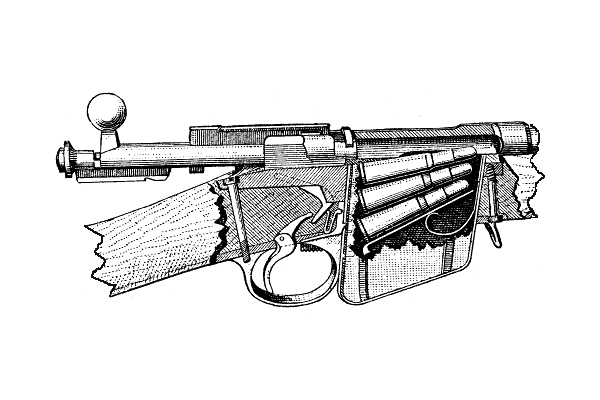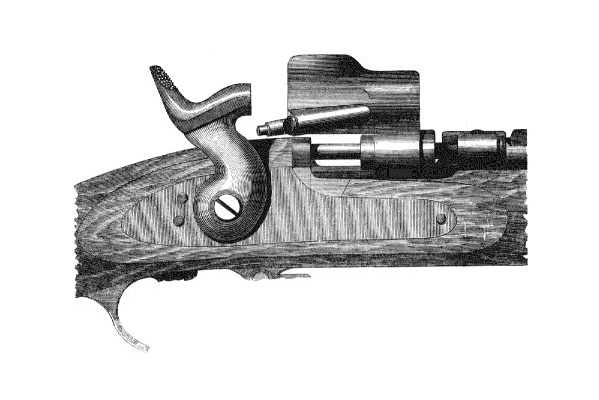Target shooting by Rifle Volunteers in the National Rifle Association (NRA) matches was primarily with their arm of issue, which in the 1860s was the Pattern 1853 Enfield rifle. Following enquires to the NRA, in April 1861 Captain Edmond H. St. John-Mildmay, the Secretary, sought a ‘definition’ of the rifle. He wrote to Major-General Charles Hay, the Commandant and Inspector-General of Musketry, at the School of Musketry, Hythe (1853-1867). Hay responded and the NRA distributed the correspondence in May 1861 which was published in numerous newspapers of the time. Mildmay’s brief covering note to the newspaper editors, and Hay’s definition follow.
Category: British Military Longarms
Articles dealing with specific arms, featuring muskets, rifles and carbines. This section also addresses arms not adopted by the armed forces but that featured in Small Arms Trials.
Browse the latest posts below, or see:
War Department Notes
In the mid 1860’s a fortunate event occurred, the vast majority of the activities of the Ordnance Department of the British Empire was captured on paper. That is to say that an immense amount of information in the form of written descriptions, original drawings, official printed reports, circulars, proformas & tables etc were bound together in the shape of 5 handsome leather covered volumes.
Managing the Enfield
The family of British Service Rifles and Carbines introduced during the 1850’s and 1860’s in 0.577 calibre marked the culmination of the soldiers’ muzzle loading firearm. This article does not attempt to deal with the historical aspects of these arms but merely to cover their modern use by enthusiasts. It has to be assumed that the person wishing to shoot these arms can show that he is a competent shot with rifles that are already established as being accurate. The author hopes that these notes intended for the guidance of the newcomer to that superb rifle, the Enfield, will prove of assistance and that, perhaps, there may even be a useful hint to the more experienced.
Measuring Velocity
The ballistic pendulum invented by Benjamin Robins (1707 – 1751), was first used in 1740, with the object of measuring the velocity of projectiles and the resistance of the air. Electro-ballistic apparatus was seeing use by the mid-19th Century. One such device was Navez Apparatus, which saw use in Great Britain with both small arms and artillery.
Pattern 1841 Carbine
Introducing a quite rare British longarm: The Pattern 1841 Royal Sappers & Miners, &/or Royal Artillery Carbine. This comes from the design of George Lovell and is the ultimate smoothbore. The 30 inch barrel is in the new Reduced Bore of .733, a reduction of .020 from the Regulation .753 of the Infantry Musket but intended to still use the same cartridge loaded with a ball of .685.
Pattern 1838 Musket
The days of the flintlock action were numbered when Alexander Forsyth began experiments, in 1805 in the Tower of London, aimed at harnessing the power of exploding fulminates as a means of ignition. His work was expanded upon by others which eventually led to the “Musket, Rank and File for Foot Guards”, the first percussion musket to be issued in quantity to British soldiers. Today we usually simply call it the Pattern 1838.
The Brunswick Rifle
This curious arm with its two-groove bore and belted bullet remained in the hands of Regulars, Militia and Native troops for almost half a century, despite complaints of the guns inaccuracy and difficult loading system. The weapon replaced the seven-groove quarter-turn Baker rifle that had been in use for almost 25 years. The Baker in turn replaced the old smooth-bore Brown Bess.
Brunswick Rifle
INDEX. This curious arm with its two-groove bore and belted bullet remained in the hands of Regulars, Militia and Native troops for almost half a century.
Measuring Precision
The 19th saw firearms evolve from flintlock muzzle loaders, using patched round ball and black powder, through to bolt action breech loaders with smokeless powders. As firearms development proceeded, so arms and ammunition needed assessing in comparative trials by the military. In the 1860s the National Rifle Association held competitive trials to determine which rifle would be used in the final stage of the Queen’s Prize at their Annual Rifle Meetings on Wimbledon Common. The system used to measure precision of rifled arms at this time was the “Figure of Merit”.
The Lee Magazine Rifle
England has lately adopted a small-bore – 0.303 inch calibre – modified Lee magazine rifle – a Lee with most of the strong points of the mechanism modified out – after making a long series of most amusing steps of development in order to reach the conclusion that this arm was suited to her needs.
The Snider Breech-Loader Rifle
At the present time when the “Snider question” is exciting so much interest and discussion, and when the Government factories are busily employed in turning out large numbers of what will, for some time, be the national weapon, we think a description of the Snider rifle and its ammunition will not prove uninteresting to our readers.
Lancaster Oval Bore
In 1863 the “Army (Rifles)” report was published, being a ‘Report of the Committee on Small Bore Rifles and the various Systems of Rifling as tried last year.’ Large-bore and small bore rifles were tested, and the report commented favourably on the large bore Lancaster.

